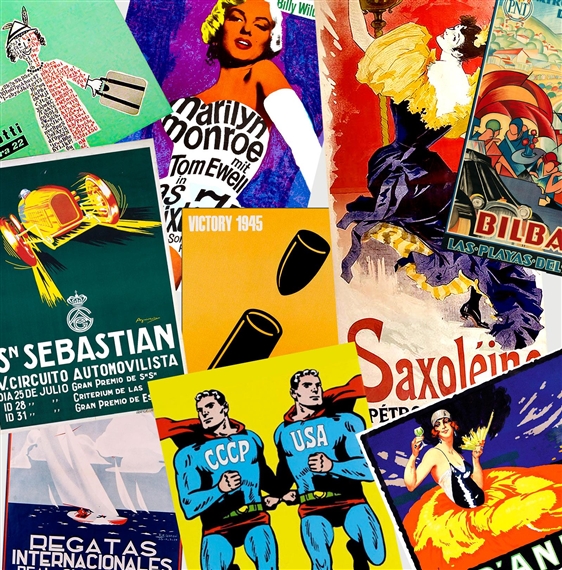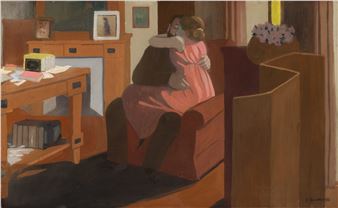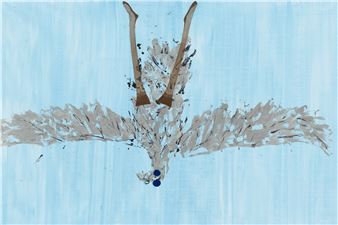Messages off the Wall
The modern poster first appeared in the second half of the 19th century, a time of far-reaching economic, political and social changes that paved the way for a a new mercantile order, the proliferation of brands and the appearance of new consumer habits. For the next century, the poster provided a very useful response to the need to advertise political events or ideas, and to promote specific products and tourist destinations.
Messages Off The Wall. Posters in the Bilbao Fine Arts Museum Collection (1886-1975) provides an unprecedented opportunity to see more than two hundred works from the Museum's extensive and largely unfamiliar collection of old posters, selected by Mikel Bilbao Salsidua, lecturer at the Department of Art & Music History at the University of the Basque Country, following research work facilitated by a BBK-Museum grant in 2008/2009. The exhaustive catalogue published by the Museum to accompany the exhibition is also the result of this investigation.
On display are works by pioneers of the poster like Jules Chéret, Théophile Alexandre Steinlen and Eugène Grasset, and others by a host of leading designers, a roster that includes such names as Leonetto Cappiello, Paul Colin, Jean Carlu, Charles Loupot, Ludwig Hohlwein, Raymond Savignac, Saul Bass, Milton Glaser, Roman Cieslewicz, Giovanni Pintori, Jan Lenica, Armando Testa and Shigeo Fukuda. Also in the exhibition is a significant representation of Basque posters, illustrating work done in this field by major painters like Adolfo Guiard, Aurelio Arteta, Antonio de Guezala and Elías Salaverría. Also included are posters by outstanding draughtsmen such as Rafael de Penagos, Federico Ribas, Emilio Ferrer i Espel, Josep Morell, Manolo Prieto and Josep Artigas.
Covering the years 1886-1975, the exhibition goes from the oldest poster, created by Adolfo Guiard (Bilbao, 1860-1916) in 1886 to several posters from 1975, including Victory 1945 by prestigious graphic designer Shigeo Fukuda (Tokyo, 1932-2009).
Divided into seven themes (posters for tourism, bullfights, trade and commerce, sports, politics and war, trade fairs, exhibitions and congresses and culture and entertainment), the exhibition enables the spectator to appreciate the way posters, advertising and graphic design developed over the years, and the poster's capacity to absorb a broad range of artistic idioms of the 19th and 20th centuries. It is, then, a journey through a century of the poster, an object designed to be ephemeral and which, despite its intended brief passage, very early on became a collector's item.

Recommended for you
The modern poster first appeared in the second half of the 19th century, a time of far-reaching economic, political and social changes that paved the way for a a new mercantile order, the proliferation of brands and the appearance of new consumer habits. For the next century, the poster provided a very useful response to the need to advertise political events or ideas, and to promote specific products and tourist destinations.
Messages Off The Wall. Posters in the Bilbao Fine Arts Museum Collection (1886-1975) provides an unprecedented opportunity to see more than two hundred works from the Museum's extensive and largely unfamiliar collection of old posters, selected by Mikel Bilbao Salsidua, lecturer at the Department of Art & Music History at the University of the Basque Country, following research work facilitated by a BBK-Museum grant in 2008/2009. The exhaustive catalogue published by the Museum to accompany the exhibition is also the result of this investigation.
On display are works by pioneers of the poster like Jules Chéret, Théophile Alexandre Steinlen and Eugène Grasset, and others by a host of leading designers, a roster that includes such names as Leonetto Cappiello, Paul Colin, Jean Carlu, Charles Loupot, Ludwig Hohlwein, Raymond Savignac, Saul Bass, Milton Glaser, Roman Cieslewicz, Giovanni Pintori, Jan Lenica, Armando Testa and Shigeo Fukuda. Also in the exhibition is a significant representation of Basque posters, illustrating work done in this field by major painters like Adolfo Guiard, Aurelio Arteta, Antonio de Guezala and Elías Salaverría. Also included are posters by outstanding draughtsmen such as Rafael de Penagos, Federico Ribas, Emilio Ferrer i Espel, Josep Morell, Manolo Prieto and Josep Artigas.
Covering the years 1886-1975, the exhibition goes from the oldest poster, created by Adolfo Guiard (Bilbao, 1860-1916) in 1886 to several posters from 1975, including Victory 1945 by prestigious graphic designer Shigeo Fukuda (Tokyo, 1932-2009).
Divided into seven themes (posters for tourism, bullfights, trade and commerce, sports, politics and war, trade fairs, exhibitions and congresses and culture and entertainment), the exhibition enables the spectator to appreciate the way posters, advertising and graphic design developed over the years, and the poster's capacity to absorb a broad range of artistic idioms of the 19th and 20th centuries. It is, then, a journey through a century of the poster, an object designed to be ephemeral and which, despite its intended brief passage, very early on became a collector's item.
Artists on show
- Adolfo Guiard y Larrauri
- Antonio de Guezala
- Armando Testa
- Aurelio Bibiano de Arteta y Errasti
- Charles Loupot
- Elías Salaverría
- Emilio Ferrer
- Eugène Grasset
- Federico Ribas Montenegro
- Giovanni Pintori
- Jan Lenica
- Jean Carlu
- Josep Artigas
- Josep Morell
- Jules Cherèt
- Leonetto Cappiello
- Ludwig Hohlwein
- Manolo Prieto
- Milton Glaser
- Paul Colin
- Rafael de Penagos
- Raymond Savignac
- Roman Cieslewicz
- Saul Bass
- Shigeo Fukuda
- Théophile Alexandre Steinlen
Contact details


 ARTISTS
ARTISTS















